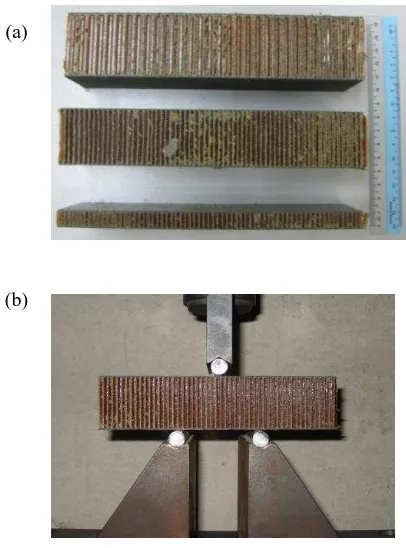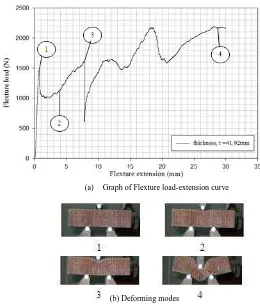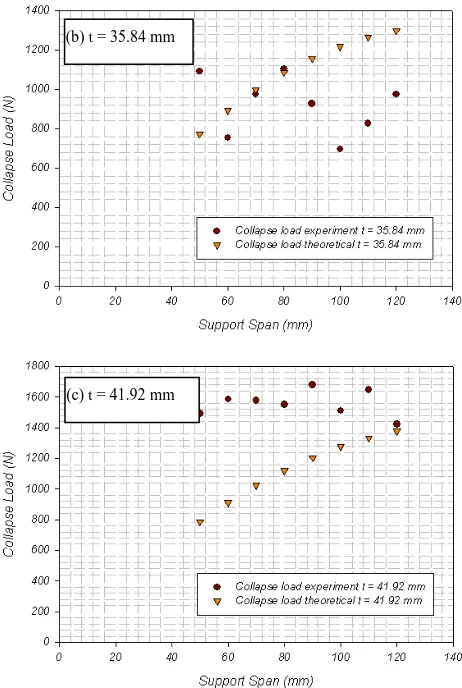Experimental investigation of Paper Honeycomb
subjected to quasi-static loading
M. R.Said
Faculty of Mechanical Engineering, Universiti Teknikal Malaysia Melaka, Hang Tuah Jaya, 76100 Durian Tunggal,
Melaka,Malaysia. [email protected]
M. K. Ismail
Faculty of Mechanical Engineering, Universiti Teknikal Malaysia Melaka, Hang Tuah Jaya, 76100 Durian Tunggal,
Melaka,Malaysia. [email protected]
Abstract—Three point bending test is performed to investigate the collapse load of paper honeycomb sandwich panel. Three panel thickness were considered; 9.1 mm, 35.84 mm and 41.92 mm with an eight span length. Eight span lengths range from 50 mm to 120 mm with 10 mm increment are compressed with 2 mm/min. The Paik’s theoretical collapse load is adapted and compared with experimental results.The agreement between experiment and theory are only found at d= 50mm,70 mm and 120 mm.
Keywords- Honeycomb sandwich structure, Bending stress, Three-point bending, Quasi-static
I. INTRODUCTION
Sandwich panels with honeycomb cores have been studied by many researchers[1,2,3,4] due to their high specific strengths and stiffness. Yang and Qiaohave performed a quasi-static indentation behavior of honeycomb sandwich materials which will be applied in impact simulations and found that the corresponding global stiffness changes in the load versus displacement curve clearly depict the three loading stages of failure process (i.e., initial core yielding load, global transition load, and ultimate failure load)[2].
Crupi and Montaini [3] have conducted static and dynamic three-point bending test on aluminium foam sandwich to characteristics of aluminium honeycomb sandwich panels using a series of strength tests, namely three-point bending tests, buckling/collapse tests and lateral crushing tests. They also carried out a theoretical study to analyze the elasto-plastic bending behavior, buckling/ultimate strength and crushing strength of sandwich panels subject to the corresponding load component.
Foo et. al.[5] studied about the mechanical properties of Nomex material and Nomex honeycomb structure, which focus
on this Nomex material. They performed tensile tests on the Nomex paper of the honeycomb to determine the mechanical properties in the fiber (or machine) direction and transverse (or cross-machine) direction. In order to determine the three
fundamental Young’s moduli, in-plane tensile tests and
out-of-plane compressive tests were conducted.
Herup and Palazotto[6] investigated the low velocity impact and static indentation test on sandwich plates to characterize damage initiation as a function of facesheet thickness and loading rate. Static indentation test show damage that is similar to that produced by low-velocity impact.The mechanical behaviour of a sandwich panel depends on the properties of the face and core materials and on its geometry. In most applications the panel must have some required minimum stiffness, it must not fail under some maximum service loading and it must be as light as possible [7].
Its design of load can be formulated as an optimization problem and the goal is the panel with minimum weight which meets the constraints on stiffness and strength. The optimization can be carried out with respect to the core and skin thicknesses, with respect to the core and skin materials and with respect to the core density. The properties and the collapse mechanisms of PHS panels are correlated with their physical and geometric properties and to the production process. Sandwich panels with paper core can fail by face yield, core shear, face wrinkling and indentation. The failure is expected to occur by the mode corresponding to the minimum collapse load.
The main objective of this research is to investigate the experimental collapse load of with various thickness and support spans of samples under static loading (three-point bending) and compared with theory[4].
II. EXPERIMENT
A. Specimen
thicknesses have been selected for this experimental investigation is 9.1mm, 35.84mm and 41.92mm.
The dimensions were chosen from previous research of aluminium foam sandwiches by Crupi and Montanini [3]. The sample dimension also follows the ASTM International standard that state the test specimen shall be rectangular in cross section. The depth of the specimen shall be equal to the thickness of sandwich construction, and the width shall be not less than twice the total thickness, not less than three times the dimensions of a core cell, not greater than one half the span lengths.
B. Bending Test
Three-point bending tests were performed by means of a universal testing machine, Instron Floor Mounted Material Testing System (INSTRON 5585) with maximum load of 200kN. The load was applied at a constant rate of 2 mm/min. The static three-point bending tests as shown in Figure 1(b) were carried out on samples with identical nominal dimensions by varying the support span d (50, 60, 70, 80, 90, 100, 110, 120 mm). For each test the collapsed load was evaluated and compared.
Figure 1. (a) Sample of Paper Honeycomb Sandwich Panel (b) Three-point Bending test
III. RESULTS AND DISCUSSION
Figure 2 shows a typical load-extension curve obtained under static three-point bending (support span d of 50mm), for the sample thickness t = 9.1mm. Different key features are clearly identified: the initial linear-elastic behavior (point 1) is
reached at load 556 N (point 2), after which the load decreases (point 3), initially markedly and then more smoothly; during this phase, energy is mainly dissipated by indention with the formation of three distinct plastic hinges (point 3&4). Then the flexture load is gradually increased with a slightly unsmooth, until it reaches to point 5 at 660 N. Then, the load suddenly dropped rapidly, followed by a cracked sound. This occurs might be due to the core of the specimen begins to fail in shear.
(a)Graph of Flexture load-extension
Figure 2. (a) Graph of Flexture load-extension curve measured undersandwich panel of t =9.1mm and d =50mm (b) Deforming modes
When the thickness of the sandwich t to 41.92mm in Figure 3, the collapse load (point 1) is 1491 N , which is larger relatively compared to collapse load of t = 9.1mm for the same support span, d = 50mm. The load decreases rapidly until it reaches at point 2, where the energy then is dissipated. After that, the loads gradually increase up to point 3 and then suddenly drop and followed by a cracked sound. The energy the gradually increased until it reached the highest point (point 4).
(a)
(b)
Figure 3. (a) Flexture load-extension curve measured under sandwich panel of t = 41.92mm and d = 50mm (b) Deforming modes
Figure 4 shows the typical variation of flexture load-extension curve for 2 types of support span, d (50mm and 60mm) and for all thickness, t.
From graph shown, the variation of collapse load for each specimen is depending on the support span. As the thickness increases, the collapse load for the specimen also increases.
Figure 4. Typical Graph of Flexure load (N) against Flexure extension (mm) for the three thicknesses (a) support span d = 50 mm (b) support
span d = 60 mm
For example, with support span, d = 50mm, specimen thickness, t = 9.1mm, the collapse load, P from experiment is 556.09N, t=35.84mm, P=1092.28N while for t = 41.92mm, P = 1491.96N.
The result of experimental collapse load is summarized in Table I. The results show the collapse load increases, if the thickness increases. However the collapse load is independent with support span. This might be due the fabrication of sandwich panels and non-uniformity material in nature.
TABLE I. EXPERIMENTALRESULTFORTHREE-POINT BENDINGONEACHSPECIMEN
Support span (mm)
Thickness of sample, t
9.10mm 35.84mm 41.92mm
Collapse load P (N)
50 556.09 1092.28 1491.96
60 571.37 754.47 1586.88
70 556.09 975.60 1578.74
80 584.30 1104.01 1551.47
90 581.06 927.16 1680.96
100 590.38 696.84 1511.87
110 564.89 826.79 1648.71
120 553.37 974.41 1423.53
(b) Deforming modes
(a) Graph of Flexture load-extension curve
a) Support span d = 50 mm
Table II shows a summary for experimental and theoretical collapse load (critical load) P and mid-span displacement δ for all specimens, from support span 50 mm to 80 mm.
TABLE II. A SUMMARY OF EXPERIMENTAL AND THEORETICAL RESULTS Support span
The comparisons between theoretical and experimental collapse load are also plotted in Figure 5. For the case of t = 9.1 mm, the theoretical collapse load overestimated by 10-20% with experiment but the curves are the same form. It only close at d = 50 mm. In contrast with t = 41.92 mm, the theoretical collapse load underestimated by 2% - 50% and closer at d = 120 mm. This might be due incompatibility between paper and aluminium honeycomb. However, for the case of t = 35.84 mm, it seems that the results valid between d = 60 mm to 90 mm. In general, the theoretical results is close agreement with experiments at d = 50,70 mm and 120 mm at t = 9.1 mm, 35.84mm and 41.92 respectively.
Figure 5. Comparison of experimental and theoretical collapse load for 3-point-bending test (a) t = 9.1 mm (b) t = 35.84 mm and (c) t =41.92 mm Malaysia Melaka and Ministry of Higher Education, Malaysia for providing the support and fund for the accomplishment of this project. The project is funded under the Fundamental Research Grant Scheme, FRGS/2010/FKM/TK01/8- F 00096.
(a) t = 9.1 mm
(b) t = 35.84 mm
REFERENCES
[1] I. Barboutis and V. Vassiliou. “Strength properties lightweight paper
honeycomb panels for furniture” (2005). Proceedings of International Scientific Conference 10th Anniversary of Engineering Design (Interior and Furniture Design). pp17-18 (2005)
[2] M. Yang and P. Qiao. “Quasi-static indentation behavior of honeycomb
sandwich materials and its application in impact simulations”. J. Aerosp. Engineering. Volume 21, Issue 4, pp. 226-234 (2008).
[3] V. Crupi and R. Montanini. “Aluminium foam sandwiches collapse modes under static and dynamic three-point bending”. International Journal of Impact Engineering 34, pp 509-521 (2007).
[4] Joem Kee Paik, Anil K. Thayamballi and Gyu Sung Kim. “The strength characteristics of aluminium honeycomb sandwich panels”. Thin-Walled Structures 35, pp 205-231 (1999).
[5] C. C. Foo, G. B. Chai and L. K. Seah. “Mechanical properties of Nomex
material and Nomex honeycomb structure”. Composite Structure 80, pp
588-594 (2006).
[6] Eric J. Herup and Anthony N. Palazotto. “Low velocity impact damage in graphite/epoxy/nomex honeycomb-sandwich plates”. Composite Science and Technology 53, pp 1581-1598 (1997).


